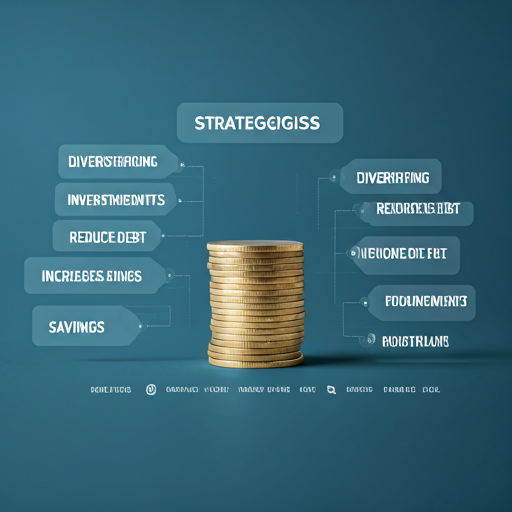Introduction to Inflation and Its Impact on Savings
Understanding Inflation: Definition and Causes
Inflation refers to the general increase in prices and the subsequent decrease in the purchasing power of money. This phenomenon can significantly impact an individual’s savings. . When inflation rises, the value of currency diminishes, meaning that the same amount of money buys fewer goods and services. This is a critical concern for anyone looking to preserve their wealth. It’s essential to understand how inflation erodes savings over time. Many people overlook this aspect.
Inflation can be caused by various factors, including demand-pull inflation, cost-push inflation, and built-in inflation. Demand-pull inflation occurs when demand for goods exceeds supply. This can lead to migher prices. Cost-push inflation arises when production costs increase, prompting businesses to raise prices. It’s a cycle that can spiral quickly. Built-in inflation is linked to adaptive expectations, where businesses and workers anticipate future inflation and adjust their prices and wages accordingly. This creates a self-fulfilling prophecy.
He must consider these factors when planning his financial future. Understanding inflation is crucial for effective financial management. It’s not just a theoretical concept; it affects real lives. As prices rise, he may find that his savings do not stretch as far as they once did. This realization can be alarming. Awareness is the first step toward safeguarding his financial health.
The Historical Context of Inflation Rates
Throughout history, inflation rates have fluctuated significantly, influenced by various economic events and policies. These fluctuations have shaped the financial landscape and affected individuals’ savings. For instance, during the 1970s, many countries experienced stagflation, a combination of stagnant economic growth and high inflation. This period was particularly challenging for savers. It was a tough time.
In contrast, the late 20th century saw a decline in inflation rates due to effective monetary policies. Central banks implemented strategies to control inflation, leading to greater economic stability. This stability encouraged individuals to save more, as their purchasing power remained relatively intact. It’s a relief to know this.
The historical context of inflation reveals patterns that can inform future expectations. Understanding these trends is vital for anyone managing their finances. He should pay attention to past events. By analyzing historical inflation rates, he can better prepare for potential economic shifts. Knowledge is power in financial planning.
How Inflation Affects Purchasing Power
Inflation directly impacts purchasing power, which refers to the amount of goods and services that can be bought with a unit of currency. As inflation rises, the value of money decreases, leading to higher prices for everyday items. This phenomenon can be illustrated through a simple table:
Year |
Price of Bread |
Price of Milk |
Price of Gas |
2020 |
$2.00 |
$3.00 |
$2.50 |
2023 |
$2.50 |
$3.00 |
In this example, the increase in prices demonstrates how inflation erodes purchasing power. Consequently, individuals find that their savings buy less over time. This is a concerning trend.
Moreover, inflation can lead to a shift in consumer behavior. As prices rise, consumers may prioritize essential goods over luxury items. This shift can affect businesses and the overall economy. It’s important to recognize these changes.
He must consider the long-term effects of inflation on his financial planning. Understanding how inflation affects purchasing power is crucial for making informed investment decisions. Awareness is key to effective financial management.
The Role of Cryptocurrency in Inflation Hedge
Cryptocurrency as a Store of Value
Cryptocurrency has emerged as a potential store of value, particularly in times of economic uncertainty. Unlike traditional fiat currencies, many cryptocurrencies have a capped supply, which can protect against inflation. For example, Bitcoin has a maximum supply of 21 million coins. This scarcity can enhance its value over time. It’s a fascinating concept.
Moreover, cryptocurrencies operate on decentralized networks, making them less susceptible to government manipulation. This independence can provide a hedge against inflationary policies enacted by central banks. As inflation rises, individuals may seek alternative assets to preserve their wealth. This is a common strategy.
Additionally, the increasing adoption of cryptocurrencies by institutional investors lends credibility to their role as a store of value. Major companies are now holding Bitcoin as part of their treasury reserves. This trend indicates a shift in perception. It’s a significant development.
He should consider the volatility of cryptocurrencies, as prices can fluctuate dramatically. However, the long-term potential for value retention remains compelling. Understanding these dynamics is essential for effective financial planning. Knowledge empowers better investment decisions.
Comparing Cryptocurrencies to Traditional Assets
When comparing cryptocurrencies to traditional assets, several key differences emerge that can influence investment strategies. Cryptocurrencies, such as Bitcoin and Ethereum, are characterized by their decentralized nature and limited supply. This contrasts sharply with traditional assets like stocks and bonds, which are often subject to inflationary pressures. The fixed supply of many cryptocurrencies can serve as a hedge against inflation. This is an important consideration.
Furthermore, cryptocurrencies operate on blockchain technology, providing transparency and security. This technological foundation can enhance trust among investors. Traditional assets, while regulated, can be influenced by market sentiment and economic policies. This unpredictability can be unsettling.
Additionally, the liquidity of cryptocurrencies is noteworthy. They can be traded ⁄7 on various exchanges, offering flexibility that traditional markets do not. This accessibility can be advantageous for investors seeking to capitalize on market movements. It’s a significant benefit.
He should also consider the regulatory landscape surrounding both asset classes. Cryptocurrencies face evolving regulations, which can impact their adoption and value. Understanding these dynamics is crucial for informed decision-making. Knowledge is essential in navigating these complex markets.
Case Studies: Successful Use of Crypto During Inflation
Several case studies illustrate the successful use of cryptocurrency as a hedge against inflation. One notable example is Venezuela, where hyperinflation rendered the national currency nearly worthless. Many citizens turned to Bitcoin and other cryptocurrencies to preserve their wealth. This shift was crucial for survival.
Another case is Turkey, which has faced significant inflation in recent years. As the Turkish lira depreciated, many individuals began investing in cryptocurrencies. This trend allowed them to maintain purchasing power amid economic instability. It’s q striking development.
In Argentina, citizens have historically used cryptocurrencies to combat inflation. The government’s economic policies often lead to currency devaluation. As a result, Bitcoin and stablecoins have become popular alternatives for savings. This behavior reflects a growing trend.
The following table summarizes these case studies:
Country |
Inflation Rate |
Cryptocurrency Usage |
Venezuela |
Over 1,000,000% |
Widespread adoption of Bitcoin |
Turkey |
Approximately 20% |
Increased investment in crypto |
Argentina |
Around 50% |
Popularity of stablecoins |
These examples demonstrate how cryptocurrencies can serve as effective tools for individuals facing inflationary pressures. Awareness of these trends is essential for informed financial decisions.
Strategies to Protect Your Savings Against Inflation
Diversifying Your Investment Portfolio
Diversifying an investment portfolio is a crucial strategy for protecting savings against inflation. By spreading investments across various asset classes, he can mitigate risks associated with economic fluctuations. This approach helps maintain purchasing power over time. It’s a smart move.
A well-diversified portfolio may include stocks, bonds, real estate, and commodities. Each asset class reacts differently to inflationary pressures. For instance, real estate often appreciates in value during inflationary periods. This can provide a hedge against rising prices. It’s a valuable insight.
Additionally, incorporating cryptocurrencies can enhance diversification. Cryptocurrencies have shown potential as a store of value, particularly during economic uncertainty. He should consider allocating a small percentage of his portfolio to digital assets. This can offer both growth potential and protection.
The following table outlines potential asset allocations:
Asset Class |
Suggested Allocation |
Stocks |
40% |
Bonds |
30% |
Real Estate |
20% |
Cryptocurrencies |
10% |
By diversifying his investments, he can better navigate inflationary environments. This strategy is essential for long-term financial health. Awareness is key to effective portfolio management.
Utilizing Stablecoins for Stability
Utilizing stablecoins can provide a measure of stability in an investment portfolio, particularly during inflationary periods. Stablecoins are cryptocurrencies designed to maintain a fixed value, often pegged to fiat currencies like the US dollar. This characteristic makes them less volatile than traditional cryptocurrencies. It’s a practical solution.
He can use stablecoins for various purposes, including savings and transactions. By holding stablecoins, he can protect his purchasing power while still participating in the cryptocurrency market. This flexibility is advantageous.
Additionally, stablecoins can facilitate easier access to decentralized finance (DeFi) platforms. These platforms often offer higher interest rates compared to traditional savings accounts. For example, some DeFi protocols provide yields of 5% to 10% on stablecoin deposits. This can significantly enhance returns.
The following table illustrates potential stablecoin options:
Stablecoin |
Pegged Currency |
Use Case |
USDC |
USD |
Savings and transactions |
Tether (USDT) |
USD |
Trading and liquidity |
DAI |
USD |
Decentralized finance |
By incorporating stablecoins into his strategy, he can achieve greater financial stability. This approach is essential for effective inflation hedging. Awareness of these tools is crucial for informed decision-making.
Investing in Inflation-Linked Assets
Investing in inflation-linked assets can be an effective strategy for protecting savings against rising prices. These assets are designed to provide returns that adjust with inflation, thereby preserving purchasing power. Common examples include Treasury Inflation-Protected Securities (TIPS) and rising prices-linked bonds . This approach is prudent.
TIPS, for instance, are government securities that increase in value with inflation. As the Consumer Price Index rises, so does the principal value of TIPS. This ensures that he receives interest payments based on the adjusted principal. It’s a reliable investment.
Another option is real estate, which often appreciates in value during inflationary periods. Real estate investments can provide rental income that typically increases with inflation. This dual benefit makes real estate a compelling choice. It’s a solid strategy.
The following table summarizes key inflation-linkfd assets:
Asset Type |
Inflation Adjustment |
Risk Level |
TIPS |
Principal increases |
Low |
Inflation Bonds |
Interest payments |
Moderate |
Real Estate |
Property value rise |
Variable |
By incorporating inflation-linked assets into his portfolio, he can enhance financial resilience. This strategy is essential for long-term wealth preservation. Awareness of these options is crucial for informed investment decisions.
Future Outlook: Navigating Inflation in a Digital Economy
Predictions for Inflation Trends
Predictions for inflation trends suggest a complex landscape in the coming years. Economic recovery post-pandemic may lead to increased consumer demand, potentially driving prices higher. This scenario could result in sustained inflationary pressures. It’s a critical concern.
Central banks are likely to respond by adjusting interest rates. Higher rates can help control inflation but may also slow economic growth. He should monitor these developments closely. Awareness is key.
Additionally, supply chain disruptions continue to impact pricing. As global trade stabilizes, some inflationary pressures may ease. However, geopolitical tensions could exacerbate these issues. This uncertainty is significant.
The following table outlines potential inflation scenarios:
Scenario |
Likely Impact |
Increased consumer demand |
Higher inflation |
Central bank interest hikes |
Slower economic growth |
Supply chain stabilization |
Eased inflation pressures |
By understanding these trends, he can better navigate the digital economy. This knowledge is essential for effective financial planning. Staying informed is crucial for making sound investment decisions.
The Evolving Role of Central Bank Digital Currencies (CBDCs)
The evolving role of central bank digital currencies (CBDCs) is becoming increasingly significant in the context of a digital economy. CBDCs are designed to provide a stable digital alternative to traditional fiat currencies. This innovation could enhance payment efficiency and financial inclusion. It’s an important development.
As central banks explore CBDCs, they aim to address challenges posed by cryptocurrencies and stablecoins. By offering a regulated digital currency, central banks can maintain monetary control while providing consumers with a secure payment option. This balance is crucial for economic stability. It’s a necessary measure.
Furthermore, CBDCs could facilitate faster cross-border transactions, reducing costs associated with currency exchange. This efficiency may encourage global trade and investment. He should consider the implications of these changes. Awareness is essential.
The following table summarizes potential benefits of CBDCs:
Benefit |
Description |
Enhanced payment efficiency |
Faster transactions |
Financial inclusion |
Access for unbanked populations |
Monetary policy control |
Central banks maintain oversight |
By understanding the role of CBDCs, he can better navigate the evolving financial landscape. This knowledge is vital for informed decision-making. Staying updated is crucial for effective financial management.
Preparing for Economic Uncertainty with Crypto
Preparing for economic uncertainty with cryptocurrency can provide individuals with a strategic advantage. Cryptocurrencies often operate independently of traditional financial systems, offering a hedge against inflation and currency devaluation. This independence is valuable.
Moreover, the decentralized nature of cryptocurrencies allows for greater control over personal assets. He can manage his investments without relying on banks or government institutions. This autonomy is empowering.
Additionally, cryptocurrencies can facilitate quick transactions across borders, making them useful in times of economic instability. This capability can enhance liquidity and access to funds. It’s a practical benefit.
The following table outlines key advantages of using crypto:
Advantage |
Description |
Independence |
Control over personal assets |
Quick transactions |
Fast cross-border payments |
Inflation hedge |
Protection against currency devaluation |
By incorporating cryptocurrencies into his financial strategy, he can better navigate economic challenges. This approach is essential for maintaining financial stability. Staying informed is crucial for effective decision-making.








